'Hand Over' Builds Eco-Friendly Homes For Egypt's Low-Income Communities
From teacher to construction engineer, Radwa Rostom found a way to improve Egyptian housing sustainably with her new startup, Hand Over. They use rammed earth construction to create better housing for those on informal settlements.
Updated May 22 2019, 4:40 p.m. ET
No country in the Middle East has a bigger population than Egypt, which is about to reach the new milestone of 100 million people. With the most habitable areas near the Nile River, housing problems have been a major concern for the growing trend. In order to help fix these issues, an entrepreneur went from being a teacher to a construction engineer to create sustainable housing for low-income communities in the area.
Egypt’s total population has increased from around the 30 million mark in the early 1960s to over 98 million this year. It’s rising at approximately two percent every five years. In order to keep up with that rate, hundreds of thousands of houses need to be put up to keep up with demand and to make a dent in the three million housing units that are currently needed.
While urban population has been increasing, the total percentage that urban areas represent has been dwindling since the 1980s. There’s been an increase in people choosing to live on informal settlements, which negatively impacts Egypt’s economy. Since 2011, crime and corruption has risen in these overcrowded slums, and there’s a lack of adequate healthy resources and sanitation.
These issues have led to Radwa Rostom wanting to make a difference in the Egyptian community she group up in. She founded Hand Over in 2015, an organization that would provide better housing and community centers for those on the outskirts of urban areas. How? Sustainable housing.
Construction is done with the use rammed earth walls, which are created by a mixture of gravel, sand, silt, and clay. Since the highest expense in the process is transporting these goods, the organization keeps materials local. According to Forbes, rammed earth construction “cuts more than 30 percent of carbon emissions” when compared to traditional construction.
Hand Over works with both non-profit companies and students studying architecture and civil engineering. They also offer opportunities for locals to learn and volunteer in the construction process. In the past year, the organization has seen enough growth that they’ve been able to expand their sustainable practices to the private sector.
“One of the very positive outcomes is that I am trying to deliver the message that nothing is impossible. Even if the issue seems hopeless and requires a huge effort, you can at least take a small step and try to solve it,” Rostom told Design Indaba back in 2015.
Since inception, Hand Over has now created four different projects and has made a lifestyle improvement to over 1,000 Egyptian citizens. Rostom herself used to teach children and the elderly to read and write, but has stepped up to provide housing for those who have been limited to informal settlement.
